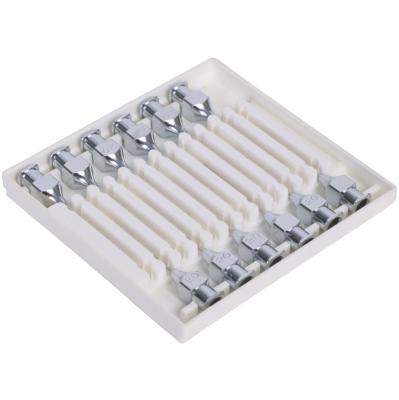
The Chevy Express was introduced in the late '90s replacing the G-Series full-size vans. It was available in 1/2-ton, 3/4 ton and 1-ton models, such as the G-Series. Although there was an issue with the front brakes wearing out prematurely, no recall was announced by General Motors to solve the problem. Many believe the front braking system (that compensated 75 percent braking capacity for the van) was inadequately suited for the full-size vehicle. Some aftermarket replacement parts may help solve the problem.
Use a clean hand pump to suck 1/3 of the brake fluid from the master cylinder of the Express van prior to replacing the brake pads. This will make room for the brake fluid being purged backwards into the master cylinder once the caliper pistons are retracted.
Lift and support the Express van with a truck jack and suitable weight truck jack stands. Place the jack stands under the front control arms.
Remove the front center caps and lug nuts using a breaker bar and socket or suitable pneumatic tool. Remove the front wheels.
Remove the two caliper guide bolts using the ratchet and a suitable socket. Some model Express vans may call for a 3/8-inch Allen wrench socket.
Pry the caliper and pad assembly off of the rotor with a pry bar or large slotted screwdriver.
Hang the caliper to the chassis with some wire so it does not damage the rubber brake hose.
Use the pry bar or slotted screwdriver to unseat the outboard pad from the caliper housing first and then pull the inboard pad from the caliper piston bore.
Compress the caliper piston using the 6-inch C-clamp and an old pad to anchor the C-clamp against. This will prevent damage to the caliper piston.
Apply a coating of brake silicone lubricant to the brake pad tabs' mating surface on the caliper anchor hardware clips.
Inspect the rotor for any visual damage such as rust pits, heat or hard spotting (discoloration on the surface plate of the rotor) or cracks. Replace the rotor if necessary but removal of the caliper anchor will be required to do so.
Install the new brake pads into the caliper. Start with the inboard pad and seat the retaining clip into the caliper piston bore. Finish with the outboard pad and use the pry bar or slotted screwdriver to get the dual retaining clips onto the outboard housing of the caliper.
Replace the caliper and pad assembly over the rotor. Apply a light coat of silicone brake lubricant to the non-threaded surface of the caliper bolts and align them with their respective holes. Tighten them with the torque wrench and suitable socket to 45-foot pounds.
Replace the wheels and lug nuts and torque the lug nuts to 135- to 145-foot pounds with the torque wrench and suitable socket.
Replace the center caps and then lower the Express van. Re-torque the wheels, if necessary, when the van is on the ground before replacing the center caps.
Pump the brake pedal several times until it feels firm. This will purge the caliper pistons from the bores and seat the pads in their proper placement. Recheck and add brake fluid to the master cylinder to ensure it is full. Test drive the van for proper braking operation.